When visiting Fossil Rim, you may have seen zebras, but what goes into make sure they are healthy?
The vast majority of Fossil Rim guests who saw zebras encountered the Hartmann’s mountain zebras in the Game Preserve pasture. Grevy’s zebras live in their own private pasture, as do Przewalski’s horses, which will be referenced in this blog as the third variety of wild equid at Fossil Rim.
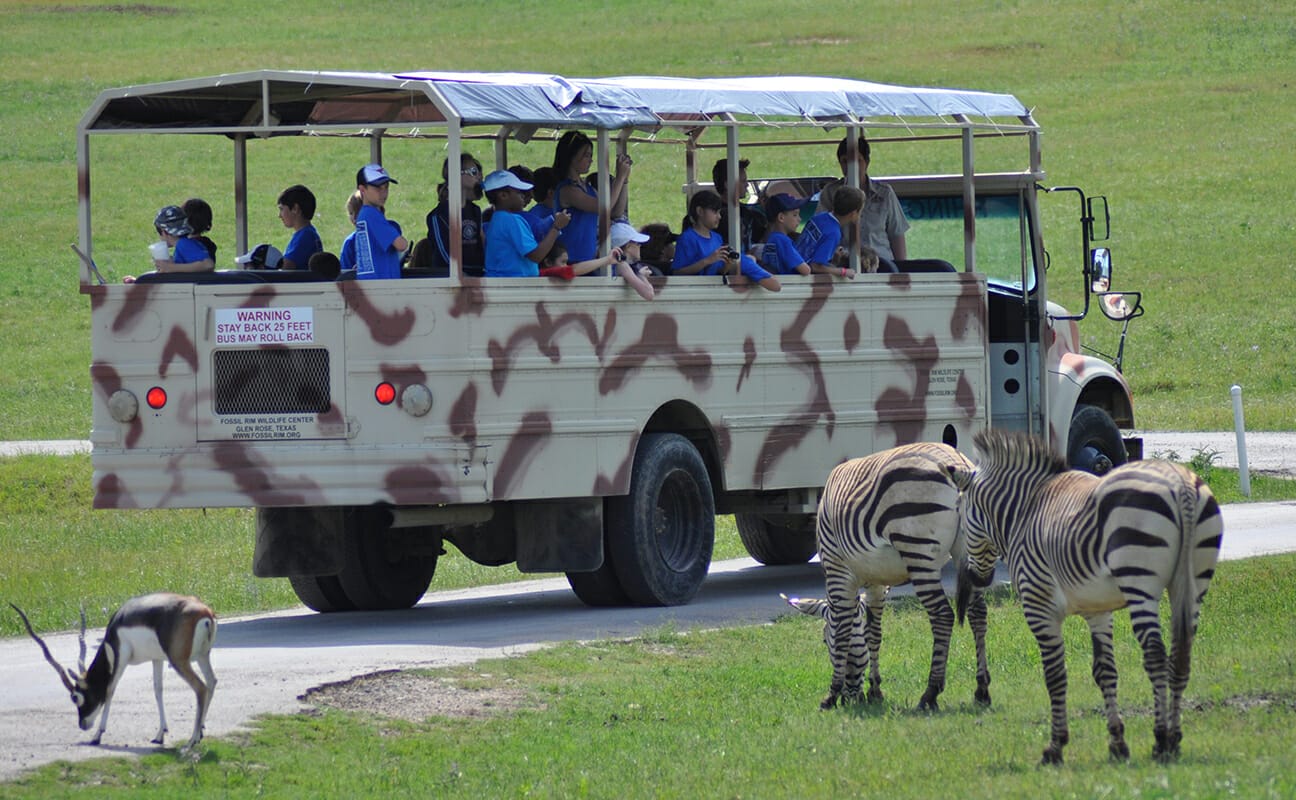
Back to the topic of animal health – Fossil Rim Associate Veterinarian Dr. Julie Swenson is going to do a deep dive on zebra care. So, what sets wild equids apart from the other herbivores at Fossil Rim?
“There are two major differences I want to discuss,” Swenson said. “First, equids are hindgut fermenters. That’s different from ruminants that ferment their food in the various chambers of their forestomach, which lies early on in the gastrointestinal tract. Equids utilize their very large cecum, which lies later on between the small and large intestines, to ferment their food; this creates several different physiologic and disease processes that differ in equids and ruminants.”
The other major physical characteristic that separates equids from most other Fossil Rim plant-eaters can be easily seen from a passing vehicle.
“When classifying animals taxonomically, all hoofstock are in one group known as ungulates. That group then splits into two groups – even-toed or odd-toed ungulates,” Swenson said. “There are many more species of even-toed ungulates – a huge group compared to the very small odd-toed group.”
Swenson loves to discuss taxonomy and she helps each veterinary preceptee at Fossil Rim learn more about how each species fits into the animal world.
“When we discuss equids, we are referring to the taxonomic family Equidae,” she said. “This includes horses, donkeys, and zebras. Equidae is part of the larger order Perrisodactyla. In addition to equids, Perrisodactyla also includes rhinos and tapirs. Perrisodactylids are also known as odd-toed ungulates or odd-toed hoofstock.
“Each of the members of this order bears the majority of their weight on an odd number of toes – one (equids), three, or five. This is in contrast to the other group of hoofstock, the artiodactylids, which includes all of our antelope and bovid species. Artiodactylids bear the majority of their weight on an even number of toes – two or four.”
She discussed how familiarity with domestic horses among Fossil Rim guests helps facilitate understanding of zebras.
“The thing about zebras, or nondomestic equids in general, is that the public is comfortable with them because they seem so similar to domestic horses, but they are definitely different,” she said. “When people take the time to learn about zebras, they begin to understand these differences. Being familiar with domestic horses provides a basis for that understanding of wild equids. In turn, understanding zebras is helpful for our guests as they learn more about our other herbivores and discover the differences between the various groups.
“Not all animals that eat grass are alike. There are distinctive differences, and nondomestic equids are a nice stepping stone for people in building that understanding. As a comparison, even though many of our ruminants are closely related to domestic cows, they look nothing like them, so it is more difficult for the public to make that connection. That’s not the case with zebras.”
You may have seen discussion of neonate exams for antelope species at Fossil Rim. What about zebra foals?
“We don’t do neonate exams on zebras unless they are ill,” Swenson said. “Dams are too protective, which makes it more dangerous for us, and the foals typically stay up with the herd as soon as they are capable of standing. This is in contrast to many of our antelope species where we frequently do routine neonate exams even if the calf appears healthy. The difference is that many of our antelope species tuck their young.
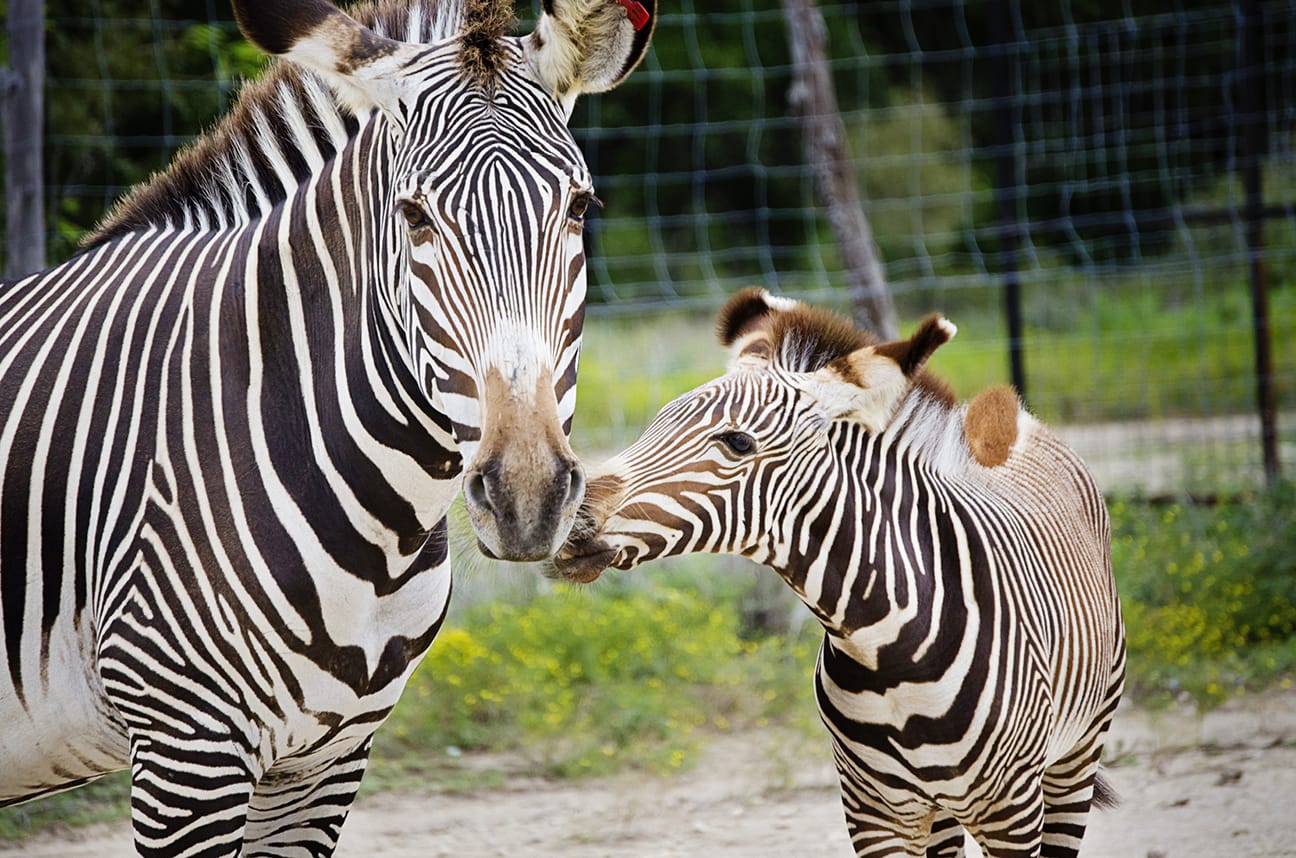
“The mother will put the calf somewhere she feels is a suitable hiding place and then leave it for several hours while she forages for food. This gives us the opportunity to get hands on the calf safely while the dam is occupied elsewhere.
“For species that don’t tuck their babies, the calf stays up with the entire herd and they will protect the calf if we try to grab it. Wildebeest are an example of an antelope species that does not tuck its calves.”
In this 2020 blog about Hartmann’s mountain zebras – https://tinyurl.com/y6xu5c2p – Molly Shea from the animal care department discussed how those zebras need higher-quality grasses than most species at Fossil Rim and require drinking water more frequently.
“Hind-gut fermenters are not as efficient as ruminants at digesting grasses, therefore they need higher-quality forage,” Swenson said. “They are not as effective at withdrawing every bit of caloric value from what they ingest.”

Both Fossil Rim zebra species and the Przewalski’s horses, or “P-horses,” eat feed pellets, grass, and coastal hay.
“It would always be nice to include more native grasses from where these animals originate from,” Swenson said. “However, our local Texas grasses seem to work well for all of our nondomestic equids. Fruits and vegetables really have no place in a zebra diet. These are grazers, and in the wild their diet is predominantly grasses.
“Fruits and most veggies are too high in sugar for what they need. High carbohydrates can lead to GI disturbances that can be very dangerous for zebras.”
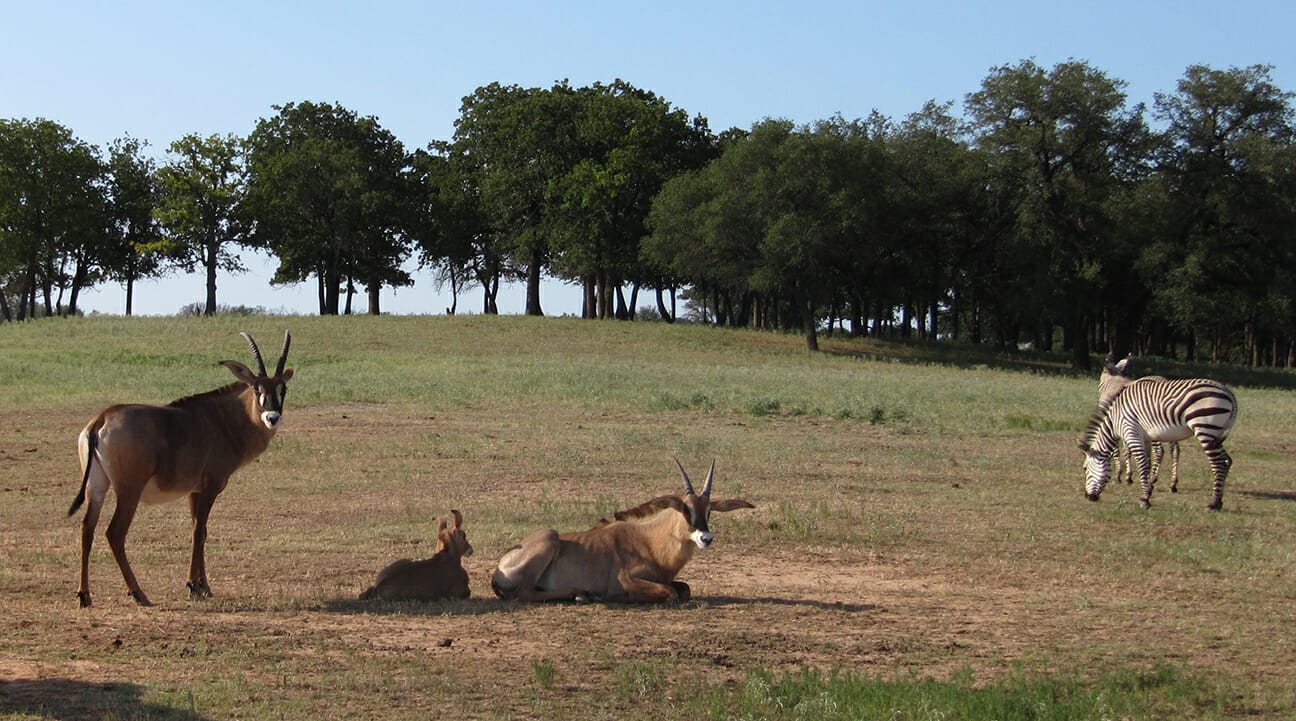
Diet also played a part when Swenson was asked about the advantages of the Grevy’s zebras and P-horses, both of which are endangered species, each living in a private pasture and thus only ever being exposed to staff members – barring a special occasion.
“There is a health benefit to those separate pastures in that they aren’t offered inappropriate food by guests,” she said. “The zebras are very good at begging for food, and there have been incidents of guests offering them items they have in their car – other than pellets – for the zebras to eat. However, these items like carrots, bread, lettuce, etc. are not appropriate food items for zebras and can cause GI upset and colic.
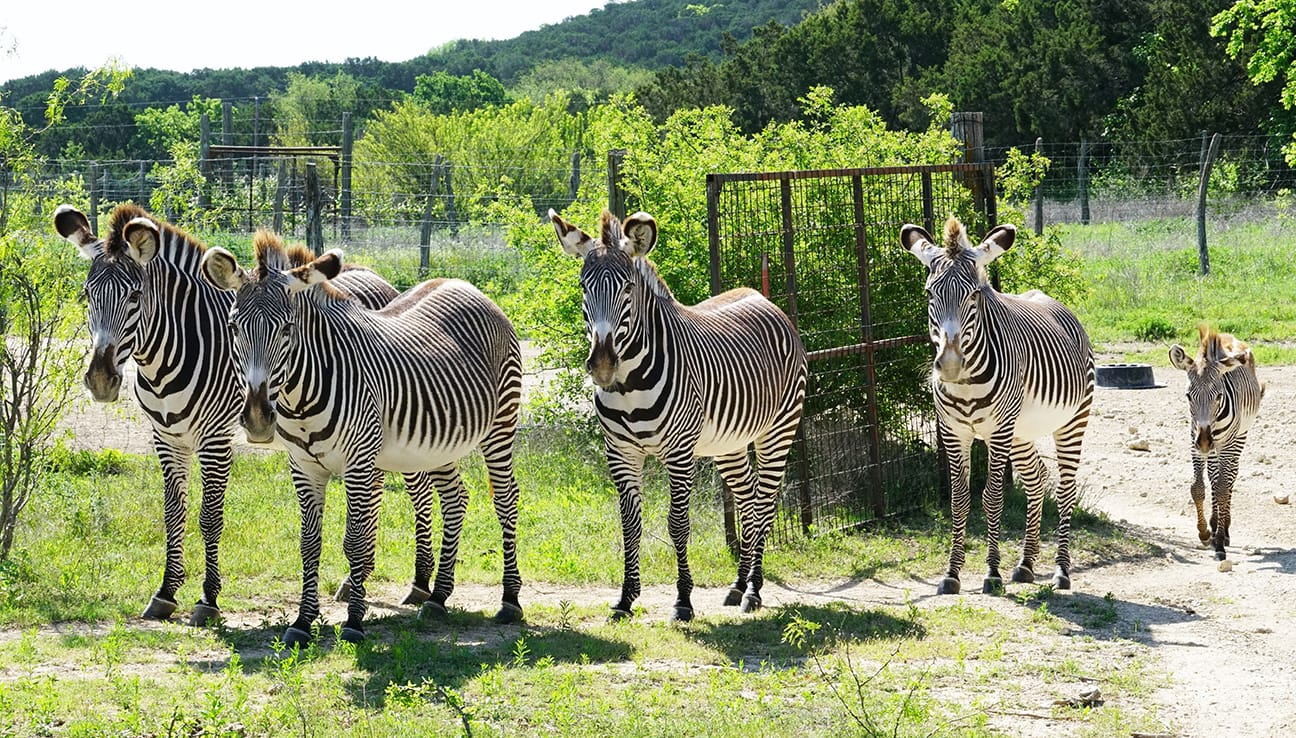
“People may mean well, but not realize that zebras weren’t meant to eat those things. Your domestic horse may love the carrots you feed it, but its digestive system is also more used to those carrots.”
She saw another advantage to the private pastures.
“Equids can be very aggressive, especially nondomestic equids,” she said. “They frequently bite and have significant dominance altercations between individuals. Plus, their hooves can cause a lot of damage when they kick each other. Having two of our equid species in private pastures keeps altercations with the public to a minimum.”
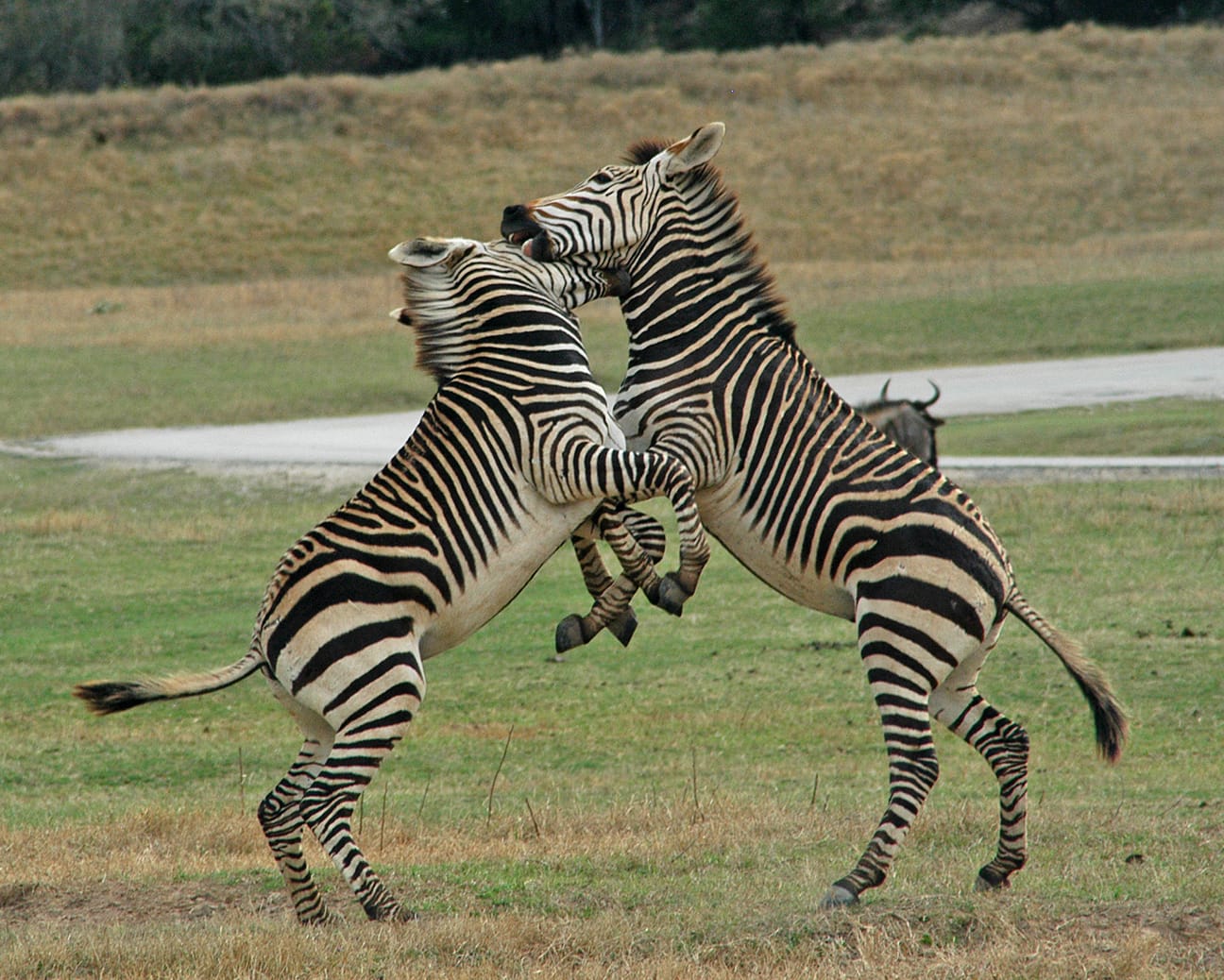
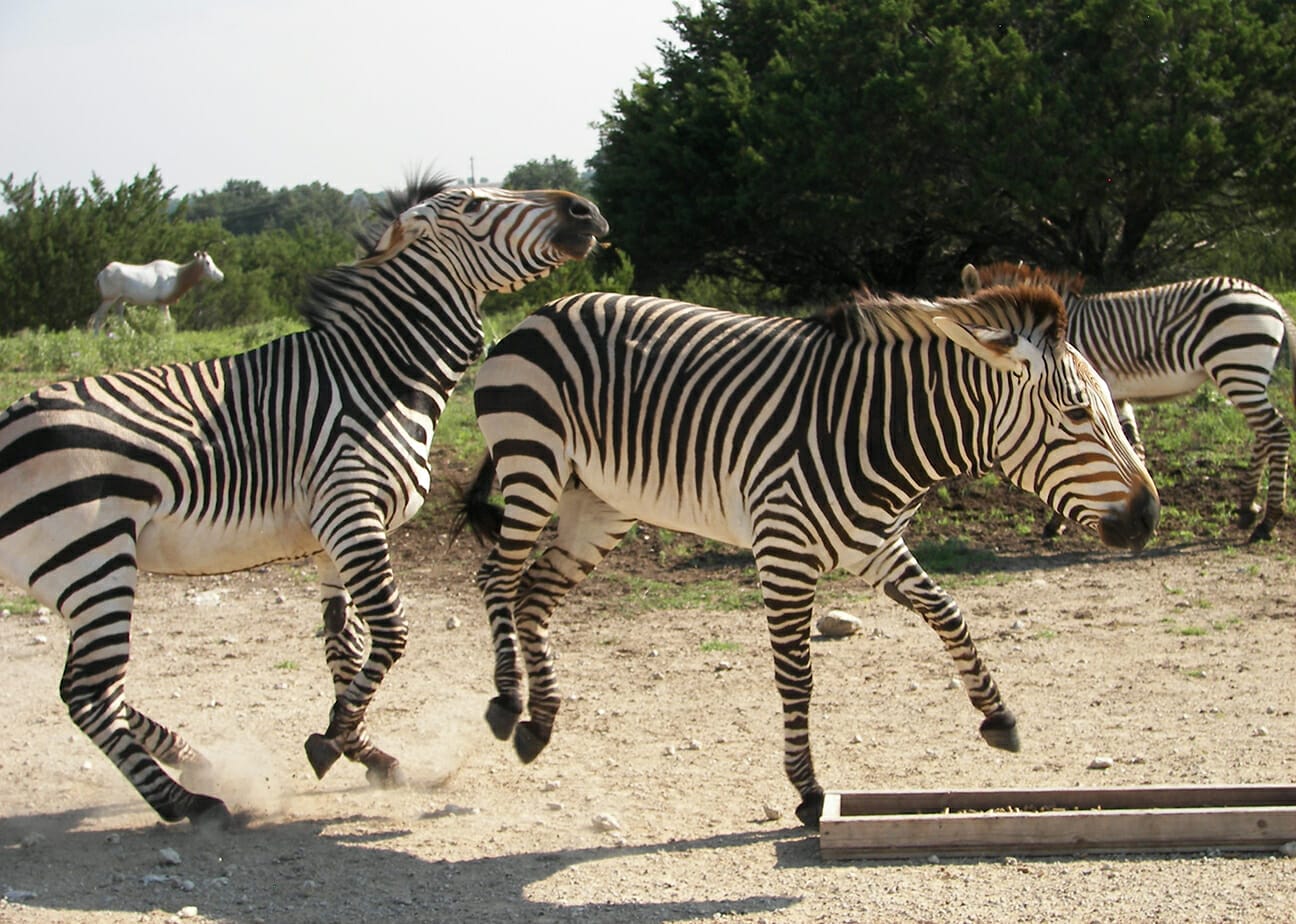
Speaking of biting, is a zebra bite the key for Fossil Rim guests to avoid among mammals? After all, an ostrich peck will always be the most likely incident, as you may be well aware of.
“Zebras do have a dangerous bite that all of our guests should be mindful of,” Swenson said. “I would like to be clear, however, that all of our ruminants can bite. Just because ruminants don’t have upper incisors, their bite is still very strong. You do not want to be bitten by any of these animals.”
Our policy of only condoning hand feeding of gentle giraffes seems to make a lot of sense.

With zebras possessing those upper incisors, does it aid their digestion compared to those ruminant species that instead have a dental pad in that portion of their mouths?
“No,” Swenson said. “The top-front teeth are not used for chewing; they are used for grabbing and tearing food items like grass stalks or during dominance altercations as a means to injure their opponent. The grinding teeth in the back of the mouth – the molars and premolars – are what chew the food that all herbivores eat. Grazers, which includes zebras and several of our bovid species like oryx, have grinding teeth that are specifically adapted to chew food very thoroughly.
“Browsers, which includes giraffes and some of our other bovid species like mountain bongo, have grinding teeth that are a bit more delicate and less able to break down harsh grasses into easily digestible fibers. Fortunately, the type of food they eat – browse – is usually easier to digest than what grazers target.
“So, the type of molar is more important than the presence or absence of upper incisors. And the type of molar is determined by the variety of food a particular animal evolved in the wild to eat.”
As referenced in the Hartmann’s mountain zebra blog, equids need to drink water more often than most animals at Fossil Rim. While antelope species like waterbuck and Nile lechwe also need to drink frequently, Fossil Rim has a number of species that only rarely need to drink.
“Equids are not desert-adapted, while many of our hoofstock species are, so the zebras require considerably more water in comparison,” she said.
When it comes to veterinary procedures required, how do zebras differ from domestic horses?
“Domestics tend to need more hoof care and dental work,” Swenson said. “They are also more sensitive to diseases like colic and laminitis, as well as several infectious diseases. In addition, because we have bred domestic horses for so long while focusing only on particular traits – size, coat style, gait patterns, etc. – this ignores the normal process of natural selection. Over time, that means we’ve bred many diseases into the population that weren’t seen in wild horses to begin with. This makes it harder for domestic horses to survive without some human care.
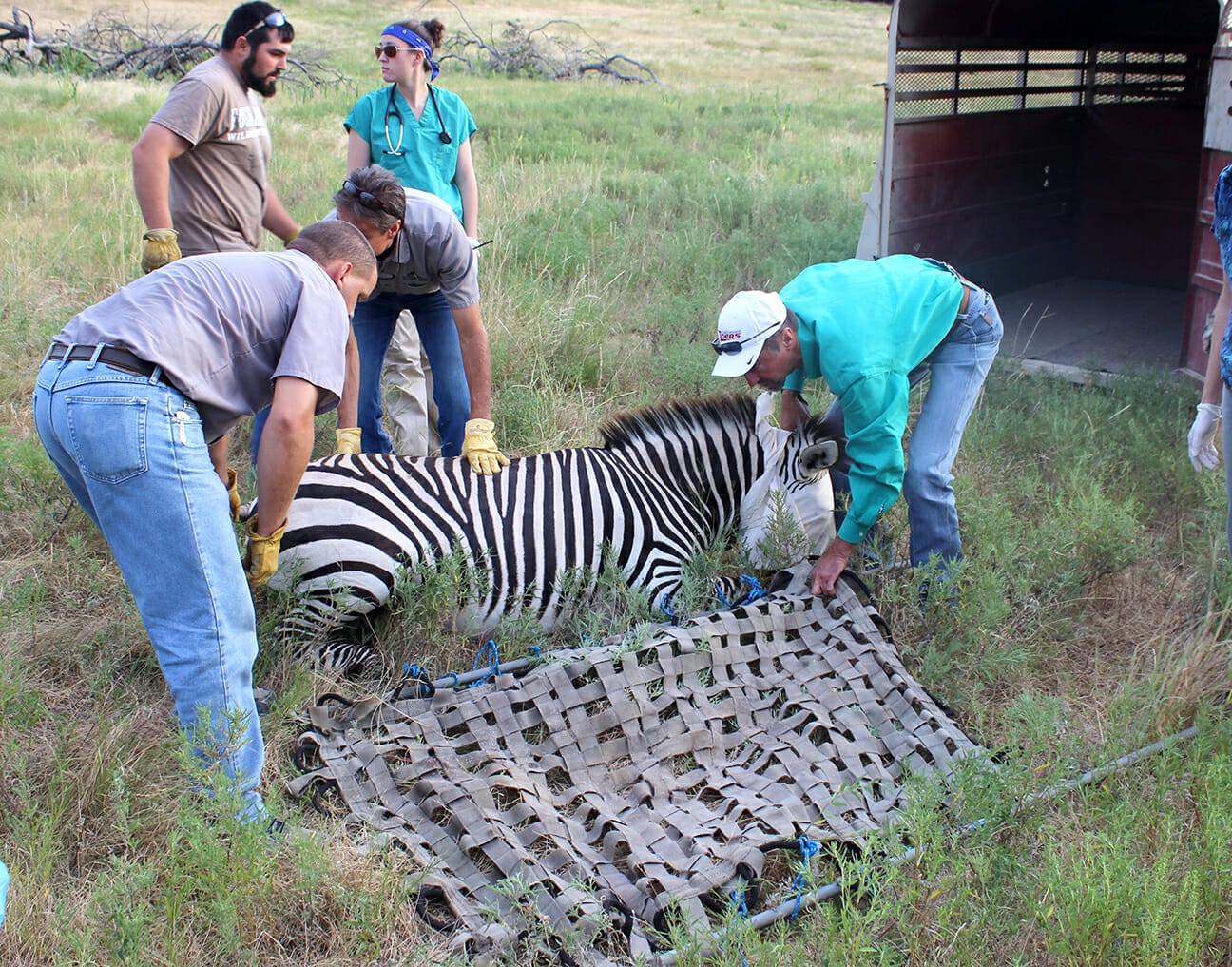
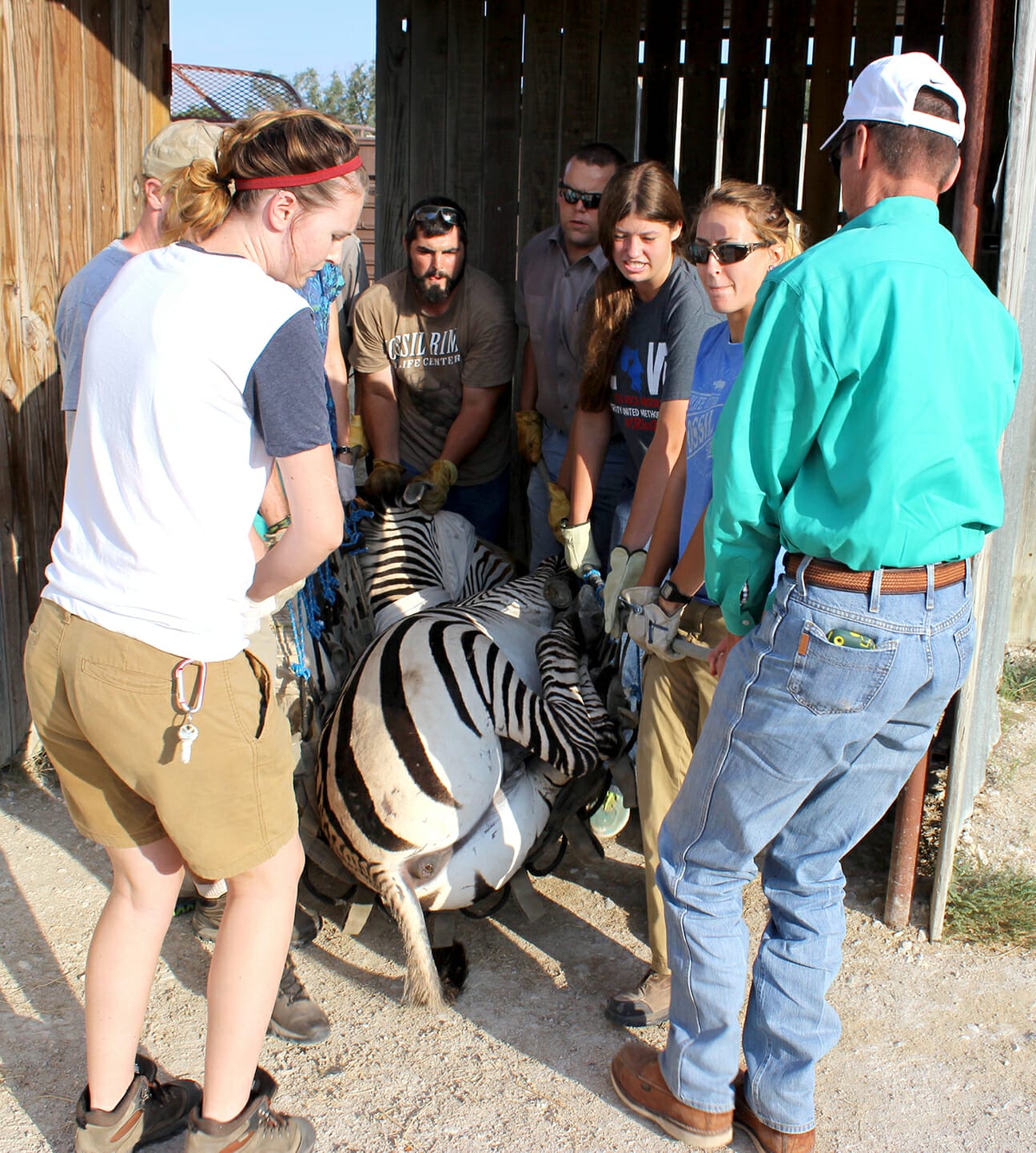

“Zebras and other wild equids, however, are incredibly tough. They’ve evolved to be very hardy animals in order to survive on their own in the wild. They are very low maintenance and only rarely do they need our assistance. They can still occasionally get colic or develop problems with hooves or teeth.
“Our biggest veterinary issue with our equids is usually a case of one zebra wounding another from bites or kicks; they can inflict a lot of damage on each other, but fortunately they usually heal very well. And it is uncommon for it to be something that requires medical intervention.
“From time to time, a situation may call for anesthesia and then treatment at the clinic for extended care of wounds. The other occasional need is when we have to move a zebra for breeding purposes, such as removing a stallion that has already been out in the herd for the appropriate number of years.”
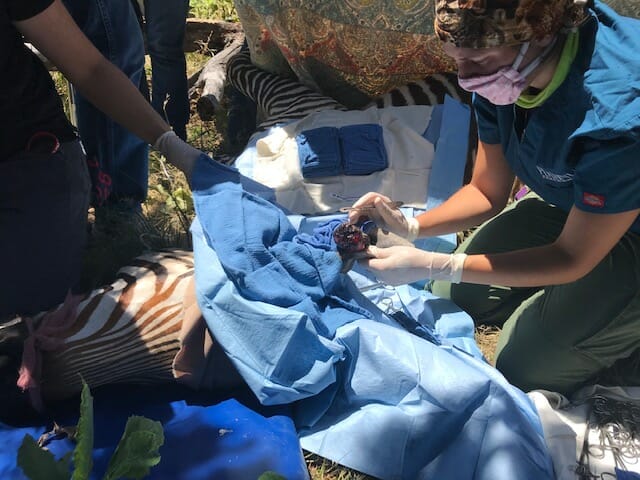
When vaccinations are needed, there is a particularly simple method that can be utilized at times and allows our staff to avoid having to immobilize the zebras for vaccinations.
“We can sometimes vaccinate our zebras by pole syringe since they’ll come right up to the vehicle for feed,” she said. “When that doesn’t work, we can usually get them vaccinated by darting. These are specialized darts that have a gel barb; once the gel is underneath the skin, it warms up and becomes less stiff, which allows the dart to fall out in a couple of minutes after it has injected the vaccine. We can then wait to see where the dart falls so we can collect it from the pasture.”
She was asked about hoof maintenance among the Fossil Rim equids.
“We rarely have significant hoof issues with either species of zebra,” Swenson said. “Both species seem to wear their feet appropriately without our intervention. We occasionally see minor issues with our P-horses and we do have a farrier come out once a year or so to do hoof trims on them.”
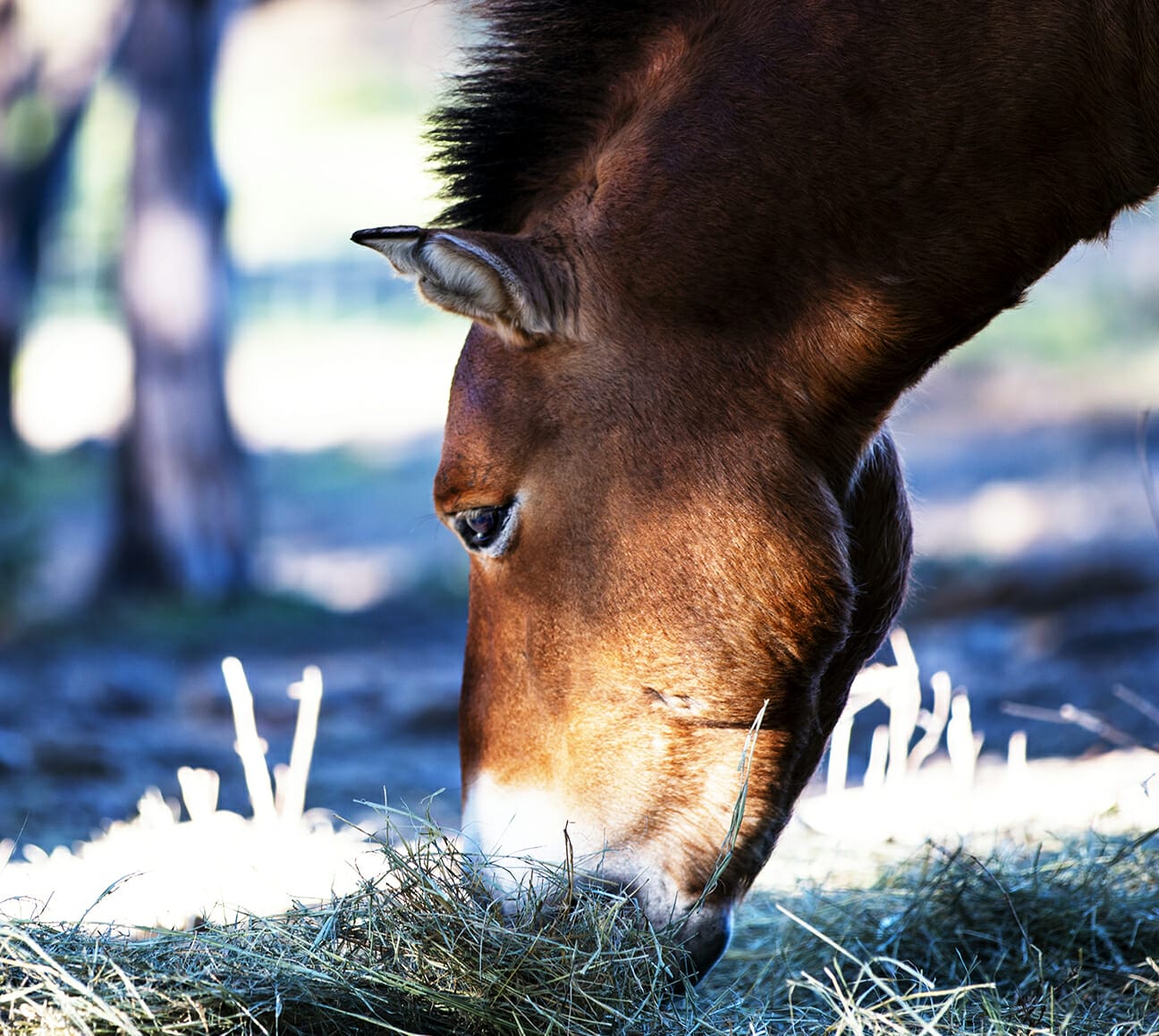
What about controlling parasites with Fossil Rim equids?
“There is a benefit to having equids in the same pastures as our ruminants from a parasite control standpoint,” Swenson said, specifically referring to the Hartmann’s mountain zebras in the Game Preserve. “We have several ruminant species here that are particularly sensitive to common gastrointestinal parasites. These parasites are found on the grass blades and are ingested by the animal while they are eating. Once in the gastrointestinal tract, these parasites can cause a number of different health problems.
“Equids also have gastrointestinal parasites, but luckily most of the parasites that affect our ruminants don’t cause disease in our equids, and vice versa. So, this allows us to use equids as a dead-end host for these ruminant parasites. The equids in the pasture will eat the grass which contains the parasites that affect ruminants.
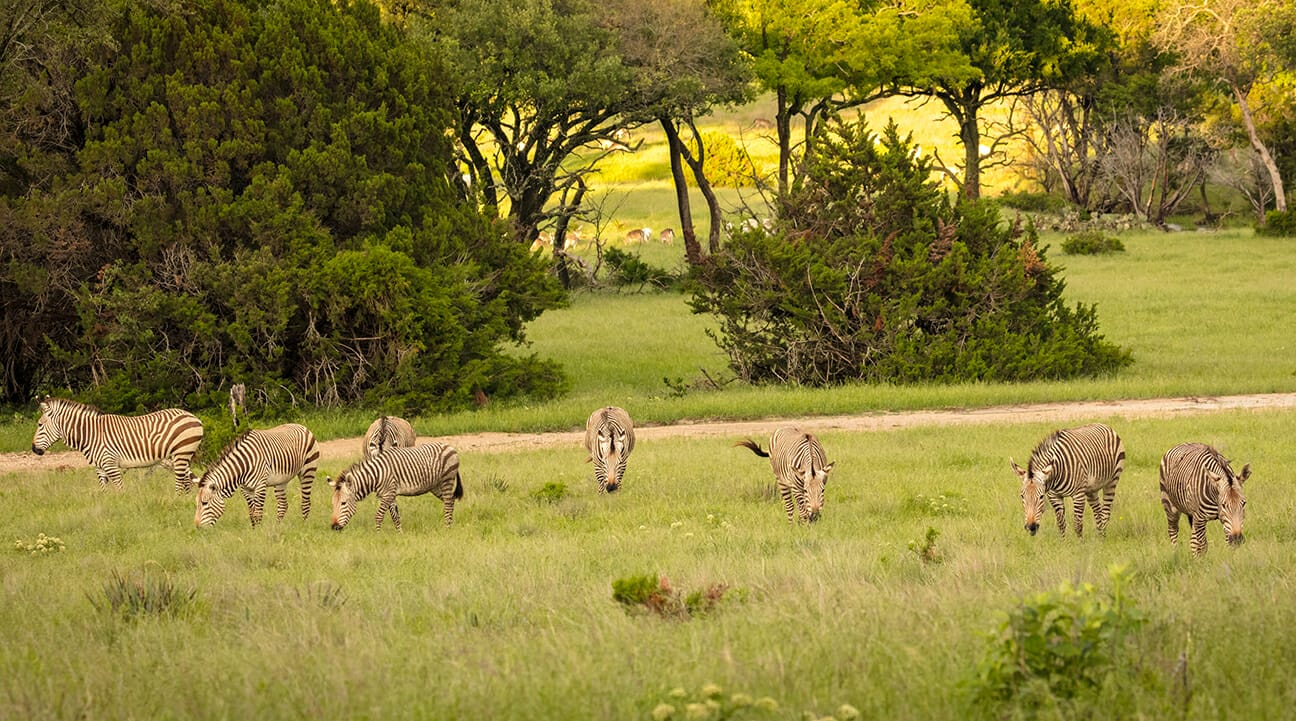
“But, those parasites can’t survive and reproduce in the gastrointestinal tract of an equid. So, the parasite dies before it can create offspring. This helps to minimize the parasite burden present in that pasture.”
Beyond the fact that two of the species are endangered and the Hartmann’s mountain zebras are classified as “Vulnerable,” Swenson discussed why she believes these wild equids are valuable to the Fossil Rim collection.
“Equids are a very important group ecologically,” she said. “They are large grazers, which allow them to clear out old vegetation to allow for new growth. They also help with seed dispersal and fertilization of the ecosystem. They are often a main food source for keystone predator species, such as lions and leopards.
“Overall, I think it’s valuable for people to recognize the importance of a given species, as well as the diversity of animals that exist. It’s easy to think that all herbivores are alike, but the reality is there are some significant differences between the animals that we house here at Fossil Rim. Zebras are an excellent example of that and one that sticks very easily in people’s minds.”
-Tye Chandler, Marketing Associate

Can Zebras safely eat raw peanuts in the shell?
I’m not sure but hopefully that’s not a question related to Fossil Rim lol. Here, and probably anywhere that has animals you can feed, they will only want you to use to food provided. If I ask our vets they’ll just worry that you are going to feed peanuts here so I won’t get an answer out of them.